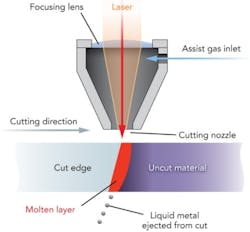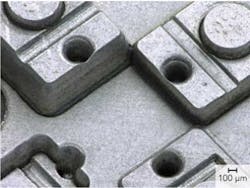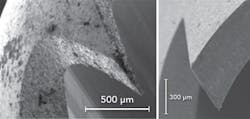
Fine laser cutting is an ideal technology for specialized cutting requirements found in the manufacturing of medical tube tools and components. Here, the term "surgical precision" aptly applies to the need for sharp edges, contours, and patterns within edges found in tools and devices in this burgeoning field.
From surgical instruments used in cutting and biopsy, to needles containing unusual tips and side-wall openings, to puzzle chain linkages for flexible endoscopes, laser cutting provides higher precision, quality, and speed than traditionally used cutting techniques. In addition, new laser cutting technologies are now coming on the market, including a 5-axis motion package that gives the designer freedom to cut more challenging geometries in one pass.
A key to successfully using the technology is properly integrating the system's components into a process flow that works. The motion, laser, software, and tooling must all work together to get the desired end product.
Laser cutting benefits
For working on small tubes that must be cut to high dimensional accuracy, laser cutting is a good choice because the laser light used does not have any physical presence and makes no contact with the material. It does not push, drag, or impart force that might bend a part or cause flex that would have a negative impact on process control.
It also offers minimal thermal input, with fine control over work area temperature. This is important since small parts heat up quickly and might otherwise overheat or deform.
Laser cutting is highly focusable to about 25 microns, which is about ¼ of the width of a strand of human hair. This makes it feasible to remove the minimum amount of material to make the cut, resulting in extremely high precision and high accuracy.
Laser cutting technology has an extremely fine control of pulse width, power, and focus spot size. Because the laser cutting tool does not rely on touching the part, it can be oriented to make any shape or form. Not limited by physical cutting geometry, laser cutting can be used to make unique shapes.
Laser cutting systems for medical tools
The technology frequently used to make medical tubes and components is fiber laser cutting with gas assist. This means that the laser is "assisted" with a coaxial gas, typically oxygen (O2). While O2 is usually the gas of choice, occasionally shop air can be used after oil filtering, usually when the tube thickness is less than 0.0001 inch, or when the cut quality required is not very high. This technology is used for stainless steels (300 and 400 series, 17-4, 17-7); MP35N (cobalt-chrome steel alloy); and Nitinol. The method can be used for both on-axis (90° to surface) and off-axis (angled to surface) cutting.
A highly focused laser is used to melt a thin sliver of material. While the material is still molten, a 0.02-inch diameter gas jet nozzle that is coaxial with the laser blows away the molten material. The desired features are produced using this continual cycle of melt, then melt ejection. Distance between the laser and the material needs to be precisely maintained.
The O2 actually serves two purposes - it blows away the molten material and also serves as a heating element - because the heated material reacts with it and heats up. The heat reaction caused by the presence of O2 adds about 30 to 50 percent more heating energy to the cutting area. The gas assist is a key factor in increasing cut speed and cut quality. FIGURE 1 illustrates a basic fiber laser cutter with gas assist. FIGURE 2 shows a close-up of an actual laser cutter at the work piece.Laser cutting with gas assist produces the highest cut quality and high resolution cut paths, a key focus of makers of medical tube tools and components. Dimensional accuracy is key to measuring cut quality - does the part match the print? Other considerations include surface roughness (better than 12 micro inches) and the absence of thermal damage.
Cut width can be extremely small with laser cutting, less than 0.001 inch, and dimensional accuracy is extremely precise, at about ± 0.0005 inch. This accuracy is very useful for producing the jagged teeth used in some cutting tools. Dross or burr left on the underside of the cut (which can become attached and re-solidified) is minimized or eliminated. This significantly reduces the amount of post-processing needed. The recast level layer (a small amount of material that doesn't get blown away during the process) is less than 0.0005 inch.
FIGURE 3 illustrates the typical cut quality with no post-processing of features and edges when cutting 0.01-inch thick stainless steel (304SS) tubing, showing the excellent quality of laser cut faces.Comparison with other technologies
Laser cutting's speed and precision compare favorably with that of the chief competing technology, electro discharge machining (EDM). To obtain the same high quality cut as a laser cutting machine, EDM requires up to four passes, which slows down processes considerably. On the plus side, EDM allows multiple parts to be processed at once.
The widths of cuts produced by a laser cutter is as small as 0.001 inch, while that of EDM is around 0.004 inch. Feature sizes are limited with EDM and sharpness is not as good, compromising cut resolution.
The EDM process is also limited by the fact that it works best with certain geometries, for example tubes with a symmetrical profile. Problems arise if there is a hole in a tube that does not go through both sides. The process is analogous to the ubiquitous cheese cutter that uses a wire to slice through a block of cheese. All is well with a symmetrical, solid shape, but the wire cannot handle any complex geometries. FIGURE 4 shows a comparison of the cut quality of EDM and laser.A final issue is floor space, especially for factories where space is at a premium. A typical EDM machine can be as large as 10 to 12 feet square, while a laser cutting system is 5 to 6 feet square.
Another technology available is electro chemical grinding (ECM), which removes electrically conductive material by grinding with a negatively charged abrasive grinding wheel, an electrolyte fluid, and a positively charged work piece. ECM is a fast cutting method that gets quality similar to EDM. With ECM, the electrolyte used must be disposed in accordance with OSHA as hazardous waste, and some electrolytes produce hexavalent chrome when cutting steels. Finally, ECM's use of hard tooling makes it much less flexible than laser cutting.
A third available technology is water jet cutting, which slices into metal using a jet of water at high velocity and pressure, or a mixture of water and an abrasive substance. Water jet cutters offer restricted cut geometry. Only symmetrical through-features or end cuts are possible using this technology.
Five-axis motion
The explosion of new non-invasive surgery tools gives rise to some unique and innovative shapes. This in turn requires motion packages that offer a new level of cutting geometry. The ability to keep a part in a machine and make intricate cuts gives designers freedom, enabling them to cut more challenging geometries in one pass.
One technology now being offered is a 5-axis laser cutting system from Miyachi Unitek. The control software controls the laser and the motion together, and the integration of these two aspects provides a rigid structure, free from vibration.
The 5-axis motion consists of three linear axes and two rotary axes. The unique set-up allows system engineers great flexibility to choose the best axis configuration for a particular cut, not limited to where they are on the part. Engineers can mix and match and set combinations that make it more efficient for a process. For example, designers might place four axes on the part and one on the focus head, or switch them around according to the best solution for the application.
System integration
Laser cutting for medical tube tools and components has many benefits, but actually achieving them depends in no small part on successful system integration. Designers need to develop an entire system where the motion, laser, software, and tooling all work properly and are integrated into a whole that supports the desired process flow.
Putting the pieces together can be a challenge, and one that is exacerbated by the fact that many integrators do not have a good understanding of the laser cutting tool, and might thus be tempted to rely on the company that makes the laser cutter to integrate the system. When or if there is a problem with the laser, or if changes are needed to adjust to a new product, the integrator is in no position to fix the system.
While not a cutting laser manufacturer, Miyachi purchases the laser from an OEM and integrates it into a complete system with motion, software, and tooling. Adding laser cutting to its already significant laser welding and marking/engraving capabilities offers designers a one-stop shop for system integration. This includes running samples of the entire process in-house, ensuring that it does the entire job as specified, and answering in-depth application questions.
Geoff Shannon, Ph.D. | Director Strategic Marketing for Precision Manufacturing, Coherent
Geoff Shannon, Ph.D., is Director Strategic Marketing for Precision Manufacturing at Coherent (Santa Clara, CA) and an Editorial Advisor to Industrial Laser Solutions. He previously served as Laser Technology Manager for Miyachi Unitek, specializing in the development of lasers and applications for existing and new markets. Shannon has a BEng in Mechanical Engineering and PhD in Laser Welding Technology from the University of Liverpool. His 20-year career in laser technology has centered around applications research and development and new product development of lasers and systems.


